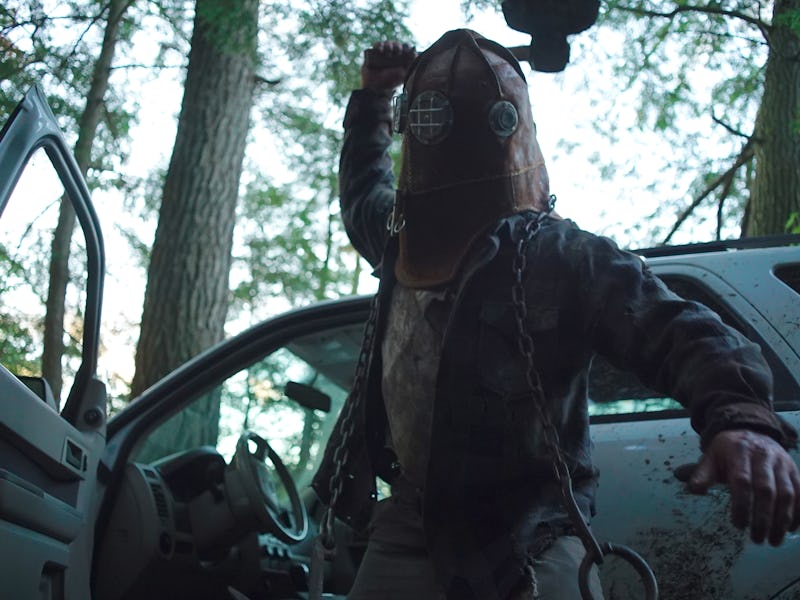In a Violent Nature Is a Lukewarm Update on Slasher Horror
The riskiest horror of the year can’t live up to its killer frame of mind.

The slasher is a staple of western cinema. It’s been around for nearly 40 years, and produced a handful of iconic villains in Jason Voorhees and Freddy Krueger. It’s also become a bit overplayed in the intervening years, forcing newcomers to think hard about what they actually want to say within — or withhold from — the genre.
Enter In a Violent Nature, a low-budget slasher from writer-director Chris Nash. The film is a novelty on its choice of protagonist alone: rather than reinvent a cast of plucky heroes to root for, Nash turns our gaze to the killers we often root against. Ry Barrett cuts a mean figure as Johnny, an immortal, Jason-esque figure awoken from eternal slumber by a group of impetuous teens. Nash doesn’t waste much time setting the character apart from his predecessors, or from making his victims very interesting. With In a Violent Nature, story comes secondary to Johnny’s gnarly kills. And in some ways, that can be a relief. But in striving to subvert the tedious trappings of the slasher, In a Violent Nature falls prey to an all-new set of issues.
In a Violent Nature is unique, gruesome, and entirely arresting... but not always at the same time. Nash takes cues from “slow cinema” auteurs like Gus Van Sant and Terrence Malick in crafting this untamed horror, and that influence manifests in a series of prolonged, ambient scenes nestled between shocking confrontations.
From the very beginning, Nature is rooted in its killer’s perspective. Before Johnny emerges from a womb-like pit in the heart of the Canadian wilderness, Nash’s camera remains fixed on the totem that’s kept him locked in purgatory: a gold locket hanging in an abandoned shed. The doomed campers that are unwittingly about to free him stand just out of frame, as disembodied voices and little else. We’ll become better acquainted with them later; once they snatch the necklace and head deeper into the woods, it’s entirely Johnny’s show.
We’re along for the ride as he trudges silently through the forest, kills his first handful of victims, and claims the weapons and mask that will define his iconography. For long stretches of time, Johnny is the sole figure holding our attention. That’s a big task for an entirely mute character, one whose face we rarely get to see. Cinematographer Pierce Derks shoots the killer’s journey like a third-person video game, placing the audience at Johnny’s back at all times. By that logic, the kills feel a lot like cutscenes — but it’s here that Nature makes its biggest impression.
In a Violent Nature turns the slasher on its head — but it can’t help itself from beating a dead horse.
Fans of practical effects will find a lot to love in A Violent Nature. Johnny’s kills are ruthless and inevitable — some split the difference between raw carnage and macabre slapstick — but they push the film into the upper echelon of slashers. Blood, guts, severed heads, and disfigured limbs all play a part in Johnny’s quiet rampage. But each fatality is just a means to an end, both for Johnny himself and for the central narrative.
Our killer harbors an unquenchable disdain for, and disinterest in, the inner lives of his victims. The audience is complicit in that at every step, which does allow us to enjoy some raucous, turn-your-brain-off gore. It’s almost enough to make up for all that aforementioned downtime. If you’ve got the patience to sit through long stretches of meditative, atmospheric shuffling, then the slow burn is certainly worth it. There’s no denying that the film is a novelty, one that stretches the very limits of the slasher conceit. But our story still clings to the threadbare themes that once set the genre apart, particularly in its repetitive final act.
For all its novelty, Nature lacks the substance, energy, or tension to hold its audience captive. Characters pop in at the eleventh hour to deliver some much-needed exposition; others emerge as half-baked horror archetypes. It does set the stage for a genuinely-gripping climax, one that finally takes the spotlight away from Johnny’s and places it in the hands of his last potential victim. Nature comes closest to sharing some form of a thesis here. But in the end it feels like too little, too late, leaving the film’s best ideas stuck in purgatory.